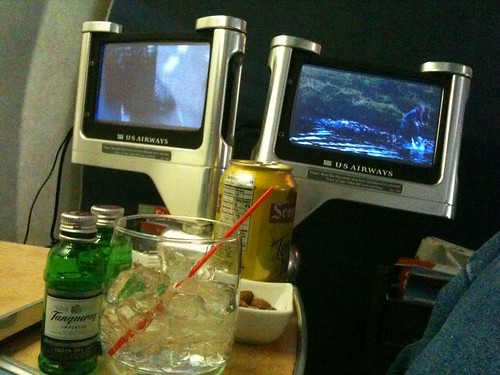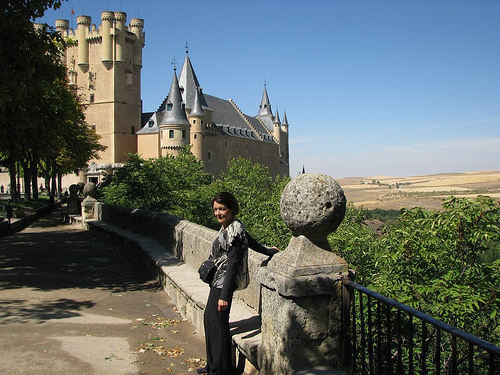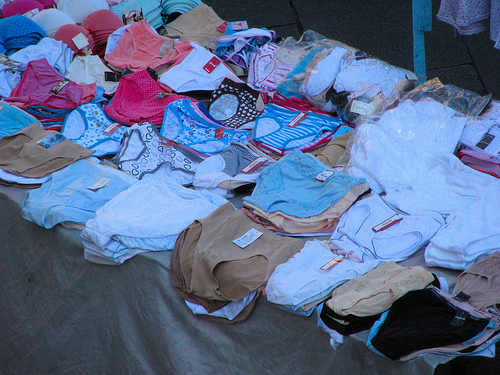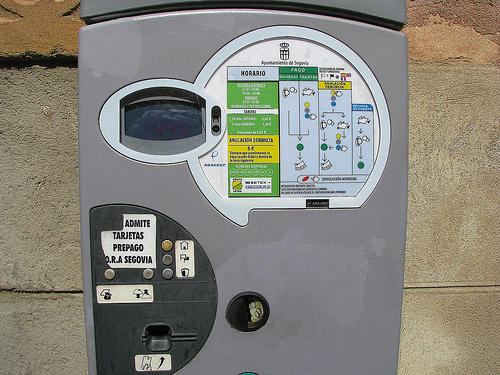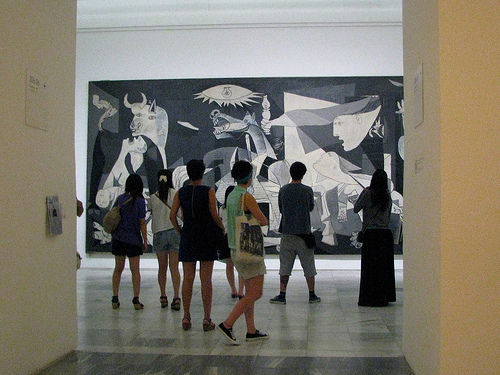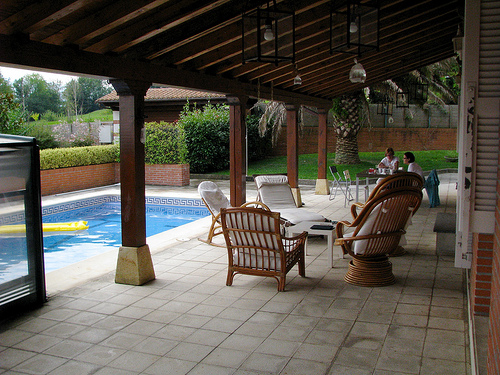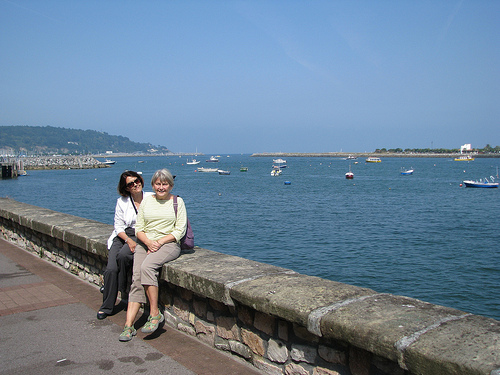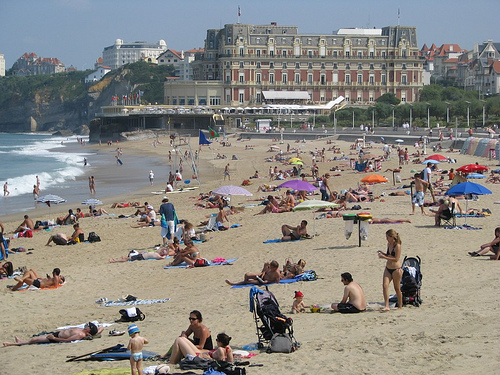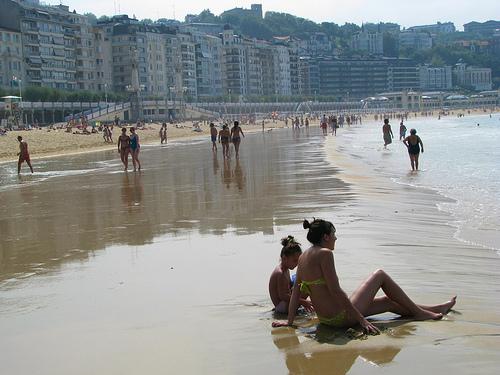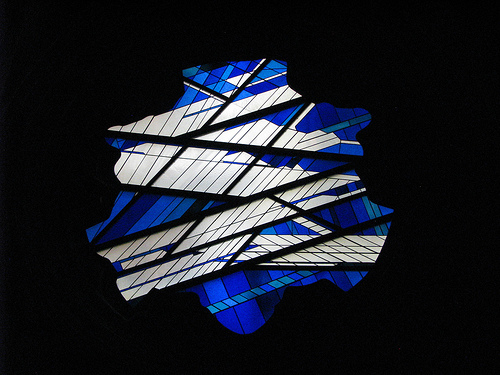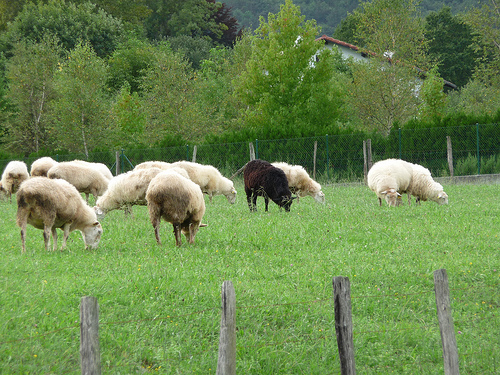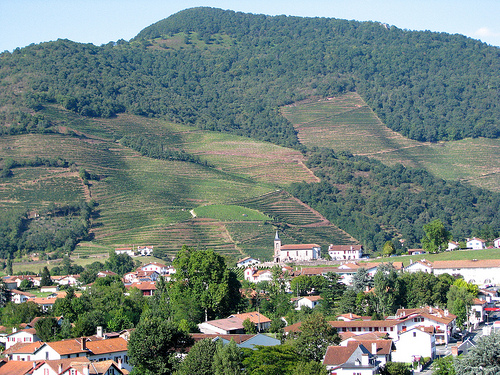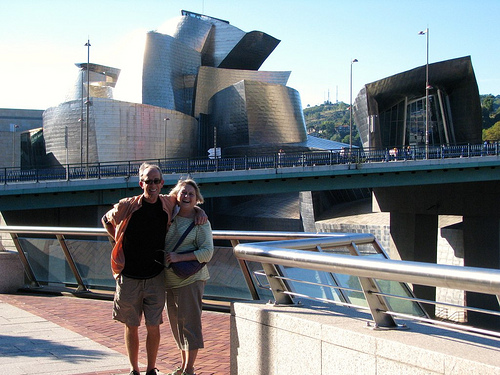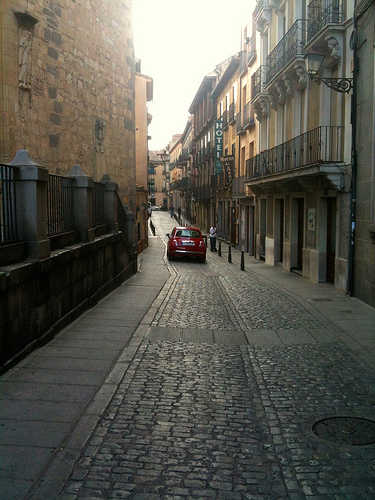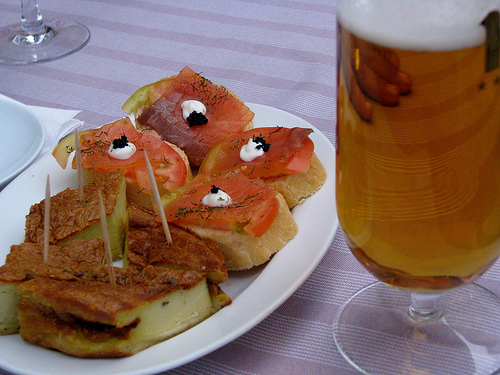Spain 2012
Here you will find all of 2012 trip to Spain in order they were posted
Report number one: – Spain
The flight was fantastic, as we were upgraded to first class (seat 1A & 1B) and had great service and food. We love US Airways as we have never had a bad flight, and this one was pretty spectacular. Arrived in Madrid in the morning, picked up our car, and drove to Segovia, where we are now checked in at Hotel Infanta Isabel. Our second story balcony offers a beautiful view of the Plaza Major day and night.
Lovely to look at, the historic center of Segovia is filled with charming shops, restaurants, tourists, and two-year-old boys being trailed by doting grandpas. The stunning Nuestra Senora De La Asuncion Y San Frutos Cathedral dominates the city and is a spectacular sight at night from our balcony. It’s on the list of things yet to explore.
View as a Slideshow or on Flickr
Segovia, Spain
The day is warm and dry and beautiful — perfect for a walk around the city and a tour of the Alcazar, the famous ancient fortress that caps the steep hill at the edge of town. Word has it this turreted castle inspired Walt Disney to create one just like it. Trust us, though. This one is much better.
For four euros, we buy tickets to explore the interior, walking in the footsteps of our tiny-footed predecessors with our giant 21st-century tourist shoes. We can almost see the shimmer of Ferdinand and Isabella on the two empty thrones. Are they really empty?
View as a Slideshow or on Flickr
Segovia Spreads Out Before Us
Excuse, please, if the two glasses of wine have affected our ability to write this, but this is a town and a time perfect for the leisurely drinking of vino tinto (so glad that we know what this means now, thanks to Kelly. But feeling a bit like Ernest Hemingway, i.e. pickled). The day starts with a buffet breakfast at the hotel — melon, specialty cakes with an amazing fine texture, and a good old Minnesota bottomless cup of coffee. We walk across the city to the Museo de Zuloaga. This ancient church was purchased by an artist in the 20s, who used it as a studio for his ceramics work. Most interesting are the drawings — largely watercolor — he created as sketches for his tile work. Also represented are paintings by nephew Ignacio Zuloaga. The museum is filled with examples of tile work, including a tile bathroom with caballeros marching across the wall, and some dead guys. Who wouldn’t want to buy a 15th century church if given the chance, and install ovens and set to creating and firing things like crazy?
Next to the Roman aqueduct, a key Segovian monument for which the city is famous. Romulus and Remus suck from their adoptive mother while we marvel at the construction of something so big and so old, made entirely without mortar, nails, or any kind of fastener. We stop for a simple lunch and order at random. Turns out to be fresh melon soup and a panini and fried potatoes and beer and Coca Cola. We watch the passing crowds. On the way back to our hotel and to our afternoon rest, was pass the local graphic arts college where everyone is smoking.
View as a Slideshow or on Flickr
Goodbye, Segovia
Yes, we are leaving, but there is still more to see. We just need to be a little quicker about it. First to the Nuestra Senora de la Asuncion y San Frutos Cathedral, which dominates the town and which we’ve been watching from across the square for three days. Its many naves and apses and chapels and paintings and sculptures are entirely overwhelming. Not to mention two pipe organs and a choir loft that holds 400. Never let it be said that Segovians of the time were an under-stated people.
But wait, there’s still time to see the printmaking museum if we hurry. It’s name is lost to us now, but we enter through a tiny door and are happy to follow the progress of print-making through time, ending with black-and-white photos of 20th century artists engaged in their print-making experiments — Matisse, Dali, Jasper Johns, Rauschenberg, and more. A quiet dinner at our own hotel, followed by an early turn-in. Because Thursday we know we will rise, eat, and check out.
But wait! There’s the Jewish Quarter to explore (even though all of the Jews were unceremoniously tossed out in 1492 or were burned at the stake), the street market that pops up out of nowhere in the morning right under our window — where one can buy piles of garlic or giant underpants.
On the way out of town, we make a side trip to La Granja, acquired by Phillip V in 1719, and converted into a Versailles-like amazement surrounded by miles of gardens. A perfect segue into our arrival in Madrid.
In comparison to sleepy Segovia, Madrid is a little like sticking your face into a spinning fan — huge, crowded, loud, city living dialed all the way up to ten. After a knuckle-biting third trip through the same set of streets, we find a parking spot underground, dump the car and limp to the Hotel Moderno, where we discover Jane and Jim relaxing at a table right outside. Hallelujah.
PS: The SUBSCRIBE form on the website should now be working and will email you wherever a new post is made. Try it!
View as a Slideshow (click photo below) or on Flickr
The Hall of Mysteries, or WTF
First attempt at parking
We found a nice parking spot in a surface lot, and after much squeezing and shuffling (small space), we stood behind a guy and watched him use this meter, which spit out his coin about 16 times until he wiped the coin on his pants (no go) and ultimately his forehead. That worked. So we did the same thing. No luck.
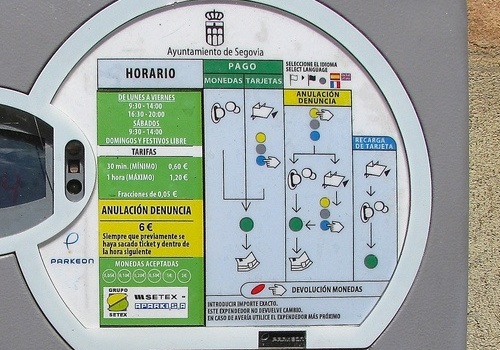
So, then we spent some time studying this helpful diagram.
Eventually, we abandoned the car.
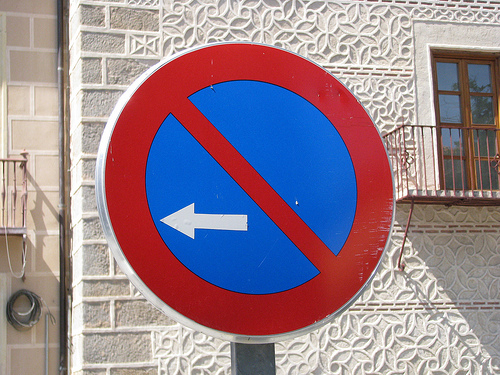
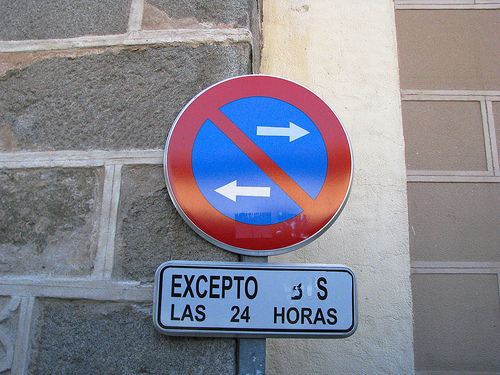
Quick! These are your choices!
So, you can either never or always go this one way, or you can choose to go both ways at once (or maybe not) except on days and times where there are exceptions.

Second attempt at parking
Looking for parking? Just follow the big blue “P” signs! Turn in to this opening.

Lots of warnings here.
We get that, so we approach with caution. When the door opens, the only thing on the other side is a small chamber and what appears to be a turntable.
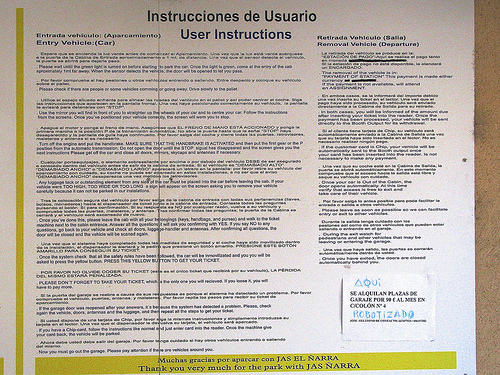
Understanding that we are out of our league, we carefully read the instructions. It appears that you position your car over the peg, and you either stay in it or leave it, and then the car is sucked into a parking hole via pneumatic tube or some such and you are either required to stay in your car in the dark, or not.
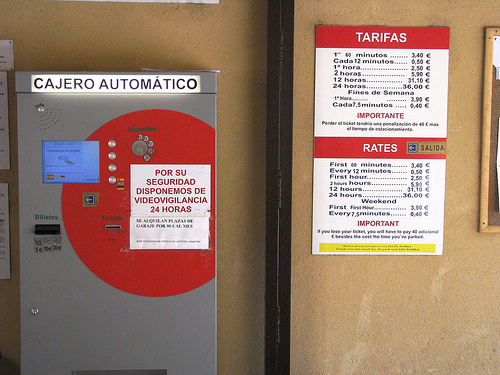
So if you’ve made it this far, you get to pay. If you can figure out how.

We think this means “adults, houses, children, balls and hockey sticks ahead — all mixed up.

This was our shower in Segovia.
We think it was probably pretty excellent, but we were never able to make it do much of anything and showered while kneeling.
Two nights in Madrid
Madrid is wild, and raucous, and teeming with life, and not for the faint of heart. Breakfast in the Hotel Moderno is well worth the ten euros, as it sets us up for a day of touring and art. The double-decker bus is a hop-on, hop-off good deal that takes us all over town and lets us leave and rejoin as we please (provided we are at the correct bus stop).
Instead of the Prado, which scares us off (with the fact that it’s the largest art museum in the world and we’re already tired), we visit the Thyssen-Bournesmisza and the Reina Sophia galleries. We are happy with our choices. We see an amazing selection of artists — Grosz, Van Gogh, Feininger, Kirchner, Lautrec, Cezanne, Gaugain, Degas, Monet, Pissarro, Renoir, Manet, Sargent, Whistler, Munch, Braque, Gris, Kandinsky, Mondrian, Klee, Chagall, Lichtenstein, Giacometti, Francis Bacon, and many more. Overwhelmingly wonderful. Our final stop is Picasso’s Guernika.
Jim finds a batch of Spanish postal workers and poses for a pic with them, except they are oblivious to what he’s doing. Lunch at the local bar, and back on the bus to tour the beautiful architecture of the city.
At night, we stroll through the crowds until we find a place to eat. Our charming Cuban waiter takes our order and explains everything to us. Then he disappears, and is never heard from again.
View as a Slideshow (click photo below) or on Flickr
First Day at the Villa, Hondaribbia
We get off to a slow start as the place is beautiful and we are all a little tired — Charlie and Jane from their long trip here from Minneapolis, and the rest of us from traveling for days and taking the long trip from Madrid to this beautiful place. The Villa Birdie is a charmer. A beautiful house that was clearly designed with the views in mind. Look out any window and you will see a mountain or a vista or a garden.
The men start with a short tennis tourney while the women read and wake up slowly. Jane takes a long, long walk. She enjoys every minute of it, but after an hour, we decide she’s lost and decide to set up a search party. Charlie will be the first to go look. When he gets lost, Mike will go. And so on, until we’re all lost. But just in time, Jane comes back and we don’t have to do any of that.
It’s very quiet here. There’s an airport nearby, but only one plane takes every every eight hours or so. Every so often, the neighbor dogs get busy barking all at once, and then stop. Life is good for them, too.
View as a Slideshow (click photo below) or on Flickr
A Day in Hondarribia
After a certain amount of confusion and consternation surrounding parking and the gizmo that takes the money, we are saved by a neighbor who manages to let us know that today is a fiesta day, so we don’t need to pay. This is great, and allows us to head straight for the waterfront and a leisurely stroll through Hondarribia. Everyone is out today. You can buy nearly any kind of knock-off you want, but we don’t buy any. Since today is a Basque holiday, there is a high concentration of handsome men in red berets and neck kerchiefs.
The sight-seeing is fine, and the people-watching is endlessly entertaining. We spend a certain amount of time watching a 2-year-old boy chase his RC car until he’s distracted by a cigarette butt that absolutely must be kicked through a hole in the sea wall. Right across the water is France, and a small ferry will take you there for a few euros.
We take pictures of the local architecture and find a bas relief that may or may not be Juan de la Cosa. Columbus’s flagship The Santa Maria was built in Basque shipyards and was the property of a Basque fellow (called a Bizkaian) Juan De La Cosa who was also its shipmaster. So the question is, was America “discovered” by Columbus? Or by a Basque? The Bizkaians would say by a Basque, and who are we to disagree?
We find a shoreline restaurant and have a relaxing meal of pizzas, salads, and crostini.
View as a Slideshow (click photo below) or on Flickr
We Dip a Toe Into France
Turns out France is mere inches away from Hondarribia, so we pile in our two cars and head on over. First stop is Biarritz. There are wonderful places to walk along the water, which today is a beautiful green-blue. The beach is protected by natural rock formations and man-made sea walls, making it the perfect spot for sunning, strolling, and painting.
After a stop for panini, frites, and crepes, we snoop in the nearby cathedral and visit the crypt of St. Eugenie (we’ll have to look her up later to find out who she was and why she’s buried at that particular church). Mike, Jim and Charlie check out the coed bathroom.
Next stop: St. John de Luz, which is lovely but we are tired and so we don’t take many pictures. Jane buys sunglasses that make her look like Jackie O. Liz buys a beaded bracelet. Jane G buys secret stuff. Life is still good. Now we are back at the villa, doing a load of darks in a washing machine that sounds like a fighter jet.
View as a Slideshow (click photo below) or on Flickr
Touring San Sebastian, Spain
San Sebastien, Spain, is much bigger than we thought it would be and all of the women seem to be wearing harem pants. We fall in love with the architecture immediately. (Side note: it took us about a half hour to figure out how to pay for parking. Our first successful effort to get a parking stub for our windshield gave us exactly 15 minutes. By the time we figured out how to get a second stub, our 15 minutes had expired. We’ll get this eventually).
Our first stroll is through the city streets to the tourist office. Jane L and Liz take a number and wait for the helper dude who speaks English. He gives us maps and ideas. We walk to the water to see the port and the beach.
We find a bar and order of mess of pintxos (pinch-ohs), the Basque version of tapas. Our waiter Ioritz is incredibly cute and takes very good care of us. The sidewalk bar sits in the shadow of the Church of San Sebastien, which is closed or we would go in for a look. At the next table is Mikell, who has two dachshunds and a good nature. He speaks English and tells us he has lived in London, Paris, Tokyo, and Rome, and that he is “in logistics.” We think he is a spy. He’s very patient and teaches us some more Basque words, and lets us take his picture.
The men and the women split up — the women to shop for gifts for the people at home and the men to head for the beach and whatever sights they can manage on the sand filled with bathing beauties, families, and people of all ages.
We reunite at 4 and head for the supermercado, which is way too super for us. Once we’re separated, we aren’t able to find each other again. Eventually, we reunite with enough for two more meals, several breakfasts, and midnight snacks. Life continues to be good.
View as a Slideshow (click photo below) or on Flickr
Exploring Orio, Deba and Getaria — or Mike and Charlie’s Bad Day
The day is cold and misty — a great day for touring in the car. We strike out, hoping the weather will clear. Orio and Deba turn out to be drive-throughs as the weather still stinks. We stop in Gataria, which hugs the coast and offers great views for those in the mood for strolling. We spy a couple from France, doing that thing couples do when they travel alone — first you take my picture, then you take mine. We offer to help so they can both be in the same picture, and they are grateful. Merci!
This is a town of fisherman with a history of exploration. Various monuments guard the town squares, including one to Juan Sebastian El Canno, who completed Magellan’s trip around the world. Steep streets are picturesque and tippy. Cold and wet, we find a warm seaside restaurant that smells wonderful and stop in for a fine meal. The daily menu is a good deal, and we all dive in.
We set the the GPS for the “scenic route” home, but then the dashboard of the rental car lights up with warnings, lights, gizmos and exclamation points. We fish the manual out of the glove box, but unfortunately, we can’t make heads or tails of it. We lose Jim, Jane, and Charlie in the roundabout. Our car lugs and lurches and the engine light goes on.
Magically, a Mercedes dealership appears out of nowhere, and we turn in. Second lucky happenstance — a woman there speaks English. She recommends we drive to the next dealership, where they repair cars. Instead, we call Hertz. They direct us to the Hondaribbia airport for a new car. Once there, we park and go inside to plead our case. The answer: a new car will be delivered to the airport in one hour. So we decide to go home first and come back, but can’t figure out how to get out of the parking lot, which is a two-step process that involves first going to one kiosk, and then to another.
Back at the villa, Charlie and Jane G are engaged in lengthy, sequential conversations with Max, Paloma, and Jeremy from ATT, trying to get the Lentz phone to work. This effort lasts an hour and a half and also includes several texts to New York City. Finally, after a successful activation, Charlie relaxes by sitting on a chair that collapses.
Having no food at the villa, we make a meal of tomatoes, crackers, goat cheese, Spanish fritos and Nutella. It’s time to give up and start over tomorrow. But life is still good.
View as a Slideshow (click photo below) or on Flickr
Hondarribia (again) and Hiruzta Winery
We head back to Hondarribia to see what we missed the first time we were here, and to eat at La Hermandad, which was recommended by Santiago in Madrid. We tried to eat there on Sunday, but it was closed, so we resolved to come back. The old town beckons, beginning with the statue of a soldier in a giant shaggy hat. Later, it’s explained to us that he is a soldier who goes ahead of the other soldiers to clear the path with his big saw. The Jaiak has just ended — the same celebration we caught a piece of on Sunday. We pop in to the library to visit with the giant puppets and to view the Jaiak posters, which we believe to have been a competition.
The historic center is small and lovely. We spend a minute contemplating the cannonball holes on the face of the Parador. Apparently, these cannonball holes are about 500 years old. Hungry, we head for La Hermandad. Fail. We are getting a complex about restaurants. Those that are on our list due to recommendation are always closed when we get there. Instead, we find a divey bar and eat pyntxos.
The men volunteer to go get the car while the women kill time on the waterfront. We are accosted by a charming young man who is either incredibly kind or up to no good whatsoever. On the way back to the villa, we stop at the winery we can see from our house. We taste the bright, bubbly Txakoli wine they make there, and check out the prices on their menu as it’s also a restaurant we could go to later, if we like. From the winery, we can see that the hill on the side of our house is covered with sheep.
It’s always 4 o’clock at Villa Birdie, and life is still very good.
View as a Slideshow (click photo below) or on Flickr
A Stop on The Way of St. James
It’s our last day at the villa, and we decide to make the most of it. Some morning sunshine gives Charlie and Mike a chance to drive to the top of the mountain and look back down on us. After a group breakfast of scrambled eggs, fried buns, and Nutella, we strike out for France and the city of St. Jean Pied de Port, a stop along The Way of St. James. Our plan was to relax in the morning so that by the time we left for town, things would be open (unlike all of the other days on our trip).
The Way of St. James, also called El Camino de Santiago, is the pilgrimage route to the Cathedral of Santiago de Compostela in Galicia in northwestern Spain, where tradition has it that the remains of the apostle Saint James are buried. St. Jean Pied de Port is filled with pilgrims, carrying walking sticks and backpacks.
We explore the town, poking into various shops containing Basque souvenirs, pepper and spices, original art, and traditional Basque textiles. Throughout is the presence of the shell, which is the symbol of The Way as it was customary for pilgrims to pick up shells along the shore as proof they had made the walk. Also apparent are “refuges,” which are sleeping spots for pilgrims. All of them are marked “complet,” or full. Too bad for sore feet. We take a quick tour of the ancient prison.
Hungry, we shop for a place to eat. Since this is our last night at the villa, we plan to eat big in town instead of buying groceries to bring home and be transformed into leftovers. But guess what? The restaurants are closed. We find one on a busy corner, and despite the fact they are unwilling to serve us anything but yesterday’s leftovers until 6:30 (it’s 5:30), we decide to stay. Our waiter is bossy and tells us what to order. We comply and pretend that it’s good.
As evening rolls in, we decide it’s best to get home before dark. Liz, Mike, Jim and Jane L decide to drive up to the top of the mountain and look down on the villa and the ocean. The hills are so steep it makes Liz remember her dream from last night, in which a cow grazing on the steep hill loses its footing, rolls downhill, and lands on the car.
We hear the sounds of the music festival in Hondaribbia floating all the way up to the top of the mountain. Cold and finished, we head back to the villa for the last of the wine. Life, as always, is good.
View as a Slideshow (click photo below) or on Flickr
Bilbao, Spain — A Lovely Surprise
Mike and Liz make it to Bilbao in good time and check into the beautiful Hotel Lopez de Haro in Bilbao. Unaccountably, we’ve been upgraded to a fabulous suite. There is a fairy following us on this trip, giving us bigger, nicer things along the way, and we don’t even need to ask. Our traveling partners, however, haven’t arrived. Where can they be? They left the villa an hour before we did, and….? So, we go for a walk on the riverfront. The river is spanned by art-y bridges with green space on both sides, and a light-rail train running alongside. It’s a beautiful day for a stroll.
Then, back to the hotel to see if the wanderers are there, and they are — hair standing on end. So far, they’ve 1) gotten into an argument with Lovely Lori, their GPS, who was relentless in trying to send them down a closed road, 2) managed to find Bilbao on their own, 3) returned their rental car to the wrong place, 4) retraced their steps to return their rental car to the right place, 5) picked up a new rental car that’s the size of a postage stamp and tried to cram all of their stuff inside, 6) chased all of Jane G’s papers down the street as Jane L obliviously sheds them as quickly as they can be picked up by helpful Spanish men trailing behind, and 7) saved Jane L from being run over by someone who was trying to park while Jane was stooped over in the parking spot (i.e. invisible).
Lunch and a beverage are next on the agenda so everybody can calm down. Then on to the Guggenheim for some and to rest for the others. The giant dog of flowers outside the museum is wonderful, as is the museum building itself. Inside, we are lucky enough to see both an exhibit of David Hockney works and a major installation by Richard Serra. The two couldn’t be more different one from the other. Mike is riveted by the fact that Hockney now does all of his work either on an iPad using Brushes or on video camera.
We gather for dinner in the hotel restaurant and have a great meal. The Menu of the Day offers good selections for all. Both the guidebooks and specific people along the way have turned up their noses at Bilbao, dismissing it as “industrial.” We find it to be a clean, modern, pretty city well worth the visit. There is plenty to do here, great places to walk, and good food to enjoy. It appears to be thriving and the people friendly.
We hug each other in the lobby as when the morning comes, there will be only four of us remaining. The G’s go home early in the morning. Adios! We will miss you!
View as a Slideshow (click photo below) or on Flickr
Segovia (again!) and Goodbye
With one unplanned day before our scheduled return, we decide to go back to Segovia and take Charlie and Jane with us. It’s on the way to Madrid, which is where we need to be for the flight home. We eat a hearty breakfast at the hotel, and hit the road. The four-hour drive takes us down out of Basque Country green hills into the country’s more brown, chaparral-like mid-section.
We are in Segovia by 3, with plenty of time to check in to the hotel, have a little beer and wine out on the square, and tour the Cathedral, which still holds surprises we hadn’t seen on our first visit. We split off from Charlie and Jane, who walk out to the Alcazar while we rest. We’ve been traveling for 16 days now, and are grateful for a comfortable bed and an afternoon snooze.
At the dinner hour, we walk down to the other side of the town and eat at a hillside restaurant that gives us a spectacular view of the valley, and is only steps away from the Roman aquaduct. As the sun sets, the colors of the buildings change from one subtle hue to another, against the backdrop of an amazing sky.
A post-dinner digestion walk gets us all ready for bed. The next morning, we meet for breakfast and say adios to Charlie and Jane. They are on their way to Portugal, and we are on our way home.
Life, as always, is good. Thank you, Spain, for everything that you are.
View as a Slideshow (click photo below) or on Flickr
Adios, Spain
Our final day is without a plan, other than to get ourselves in position near the airport in Madrid by day’s end. But Spain has so much to offer, we fill our day with good things anyway. First, we drive around outside the Segovia city walls to see the town and the Alcazar from a distance. We pass the Jewish cemetery, which is right outside the city gates.
Then, we take the scenic route from Segovia to Madrid. The land reminds us of the wide open spaces of Wyoming and Montana. Mile after mile after mile of flat ochre. We stop at a roadside restaurant, and order the menu of the day because we can’t read the menu and it’s all a big mystery to us. A kindly fellow at the next table steps in after our waitress gets good and frustrated. He tells us how to avoid highway tolls and that we should stop at the Valle de Los Caidos, where Franco is buried.
Eventually, we find it, but guess what? Closed. Looks like an interesting place though.
Once in Madrid, we check in to the Axor Feria Hotel, a swank ultra-modern number right near the airport. But first, we try to check into the other Axor Hotel, which is right next to this one and looks exactly the same. We walk to the Hertz return across the road, settle up, and then walk back to sign up for breakfast and the morning airport shuttle.
Two bottles of wine we’ve been schlepping all over tarnation need to be finished off. Finally, we walk out to see what’s nearby, and find an enormous shopping mall to rival the Mall of America. We buy a few final trinkets, mostly to get rid of at least some of the 50 pounds of euro coins we’ve accumulated over the past two weeks.
Our journey is over, and we’ve enjoyed it all. Spain is a wonderful country, with wonderful sights and friendly, helpful people. You should come here!
View as a Slideshow (click photo below) or on Flickr
